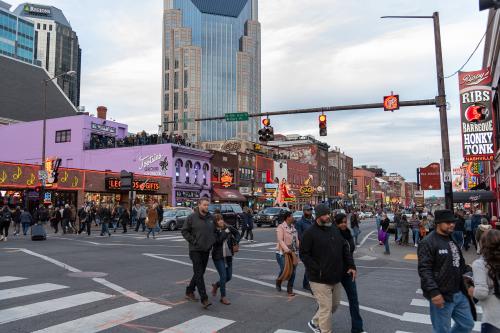A year out from next year’s presidential election, let’s dispel the pervasive myth that the federal government runs the country. Washington is essential in many ways, but all too often we forget that our nation is a federal republic, with major powers and responsibilities vested at the state and local level. Many of the determinants of our national competitiveness and economic prosperity are driven by local actors. And intractable partisan gridlock and long-term federal budgetary trends are forcing our subnational governments to take on a larger role than ever before.
For this reason, the 2016 presidential election is the right time to have an honest conversation, not just about the role of the federal government, but about federalism: the way powers and responsibilities are distributed across levels of government.
Take for example, infrastructure and education, both sure to be discussed by presidential candidates over the next year. America’s infrastructure is crumbling and not up to global standards. Our workforce does not have the education or skills necessary to compete in the global marketplace.
The solutions to these challenges do not lie in Washington. Look at the math: Compared to state and local governments, the federal government spends very little on these essential areas. In FY 2011, the federal government accounted for only 12 percent of the total funds allocated to K-12 education, while states and localities contributed about 44 percent each. Between 2007 and 2011, the federal share of public spending on highways and transit hovered around 25 percent; states contributed 40 percent and localities made up 36 percent.
Given this division of spending, it should not be surprising that the most innovative and pragmatic solutions to problems in these areas have come from states and localities. Denver, San Diego, and Dallas are making economy-shaping investments in infrastructure and public space through innovative partnerships and funding mechanisms. New York City, Chicago and Connecticut, in partnership with IBM and other technology companies, have established technology oriented schools to ensure that their city’s workforce is prepared for 21st century employment. And San Antonio, Salt Lake County, and West Sacramento have expanded preschool programs, providing children with access to high-quality early education.
It’s not just education and infrastructure. In other crucial sectors like telecommunications, clean energy, and public health, the federal role in funding and finance is also quite limited.
These examples illustrate a larger point—the world is more competitive than ever, and for our country to keep up, we need a federal government that is designed to complement the innovative efforts of our states and metropolitan areas. We need a new federalist roadmap that better aligns what Washington does with what the nation needs.
What would this new federalist roadmap look like?
First, the federal government needs to lead where it must. Many forces affecting cities, metro areas, and states transcend parochial borders and require Washington to act with national vision and purpose. It needs to do the things that subnational governments cannot do—protect the homeland, provide a robust safety net, invest substantially in research and development, and overhaul our inadequate immigration system, among others.
Second, the federal government must empower where it should. One size cannot and does not fit all in a nation as large and diverse as the United States. Federal programs and resources need to reflect the variation of our country and should be structured with fewer prescriptions. They should give local actors the flexibility to adapt them to local conditions and priorities in exchange for greater accountability. And Washington also needs to rethink the way funds are allocated geographically. For cities and metropolitan communities with particularly strong track records, more federal resources should be passed on to them directly, rather than through their states.
Finally, the federal government should leverage where it can, catalyzing private and civic investment to the maximum extent possible. With mandatory federal spending for older Americans rising, discretionary spending on infrastructure, education and other competitive levers won’t keep pace with demand and population growth. With relatively small investments, the federal government is capable of attracting large quantities of private and civic resources, like in the case of the National Network for Manufacturing Innovation. It also needs to find regulatory ways to entice private and civic investors to fill the gap. In the infrastructure realm, for example, allowing tolling on federal highways and expanding the use of innovative finance were steps in the right direction.
We are at a cross roads. Neither the mid-20th century model of “made in Washington” nor the late 20th century model of “get it out of Washington” serve the country well. We need a reliable federal partner and a federalism that reflects how the country actually operates. Presidential candidates, are you listening?


Commentary
Op-edToward a city-led federalism
November 3, 2015